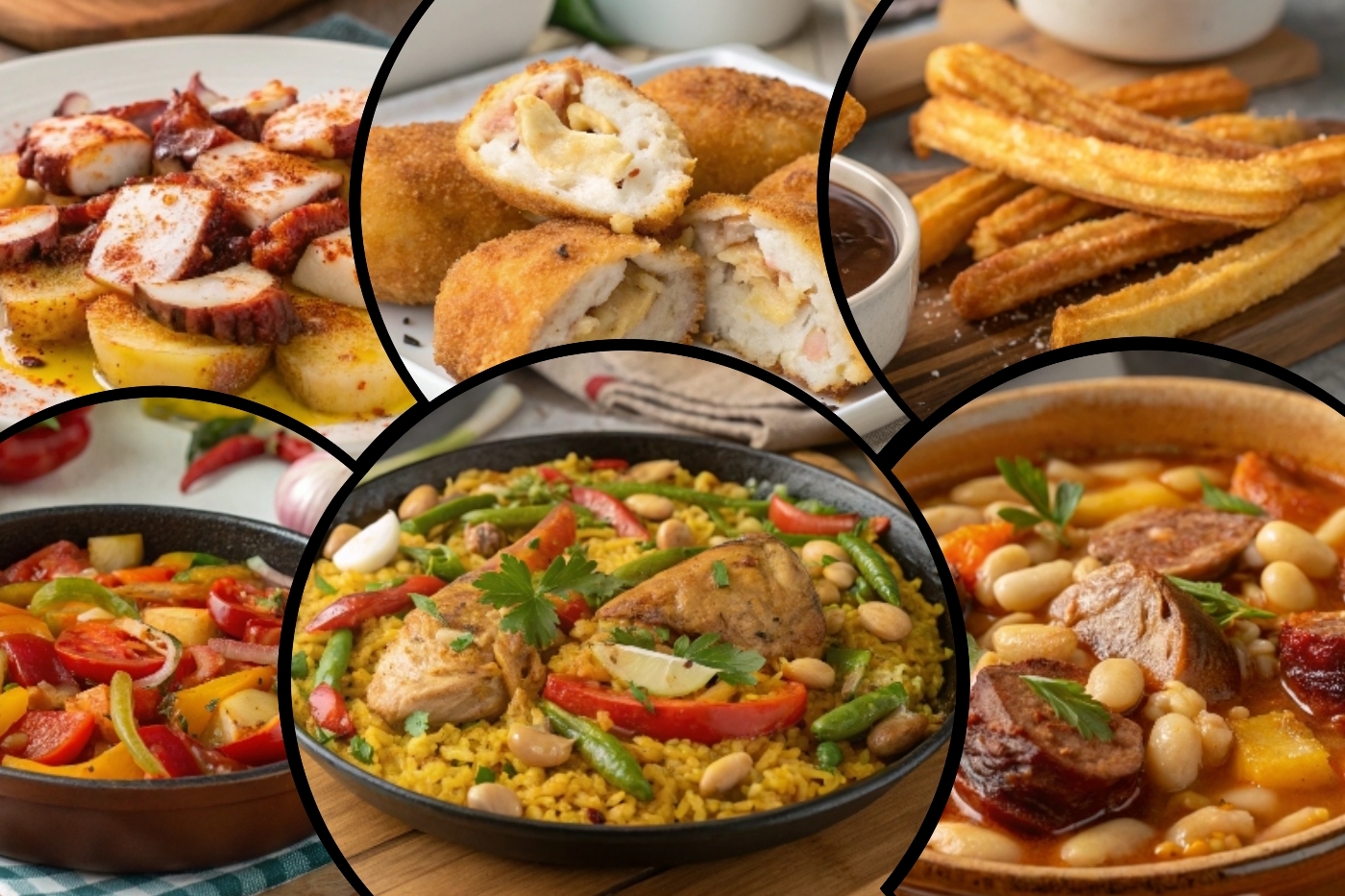On my first trip to Spain, I was immediately spellbound by the vibrant markets, the aroma of fresh produce, and the incredible hospitality that accompanied every meal. It was here I discovered the best food in Spain—dishes so full of life that they awakened my senses in ways I hadn’t experienced before. From succulent meats to garden-fresh vegetables, each recipe encapsulated centuries of culinary tradition, proving why these plates are cherished as the best Spanish food across every region.
Venturing deeper into the heart of Iberia revealed a tapestry of food cultures woven from coast to coast. In bustling tapas bars and tranquil village kitchens, I witnessed how different foods in Spanish cooking exemplify creativity, heritage, and a passionate love of dining. Gradually, I realized that what made Spanish cuisine so remarkable was its endless variety, each forkful telling a story of local landscapes and family legacies. Prepare to savor eleven dishes that define this unforgettable gastronomic journey.
Savoring Spanish Cuisine: A Cultural Tapestry
From the rolling hills of Andalucía to the misty shores of Galicia, Spanish cuisine stands as a living museum of contrasts and colors. To delve into the best food in Spain means to embark on a journey of discovery—one that highlights ancestral techniques, local pride, and the intricate bonds that unite families across generations. Even a short trip through its regions reveals the graceful dance of sweet and savory flavors, each dish carrying a piece of history on the plate.
Walk into any bustling market, and you’ll see firsthand how locals haggle over fresh tomatoes, peppers, and onions, a sight underscoring the foundation of different foods in Spanish kitchens. There’s an unmistakable energy in how produce is revered, forming the basis of so many quintessential stews, sautés, and sauces. Among these well-loved classics, you’ll find everything from hearty bean-based Fabada in the north to the chilled, refreshing Gazpacho of the south—showcasing that Spain’s gastronomic identity draws from both the land and the season.
Yet, the nation’s kitchens are not merely about nourishment; they are places of artistry, where heritage meets innovation and where older generations pass down revered secrets to eager apprentices. Remarkable cooking styles like slow braising, clay-pot stewing, and open-fire roasting testify to how best Spanish food thrives on tradition. No matter the region, communities embrace these age-old methods, mindful that their survival depends on respect for ancestral wisdom combined with a willingness to adapt for modern palates.
In Granada or Seville, for instance, small plates known as tapas exemplify the communal heart of Spanish cuisine, encouraging conversations and forging connections. Whether you pick up a bite of Tortilla Española or nibble on some sizzling Patatas Bravas, you’re partaking in a social ritual that has spanned centuries. This social dimension infuses every corner of Spain; families gather for long midday meals, sipping on gazpacho, sharing a hearty stew, and culminating the feast with sweet confections that evoke childhood nostalgia.
While many countries cling to gastronomic icons, Spain elevates them into living experiences. Farmers, fishers, and artisan producers cultivate prized ingredients—like saffron from La Mancha or acorn-fed pork from Extremadura—ensuring that the best food in Spain remains rooted in the soil and sea. Their dedication sustains the flavors that fill open-air markets, shape culinary festivals, and define an entire nation’s identity. Every region defends its culinary treasures with an unbreakable sense of pride, ensuring that authenticity never falters.
So, what sets different foods in Spanish cooking apart in a global context? Perhaps it is the delicate interplay of earthy spices, fresh produce, and slow, deliberate methods that endow each plate with unrivaled depths of flavor. Or maybe it’s the zeal with which cooks, whether home chefs or Michelin-starred maestros, delve into the power of olive oil, tomatoes, saffron, and peppers to craft sumptuous meals that echo cultural narratives. In every mouthful, you taste not just delicious food but also the story of how regional identity and tradition shaped that particular dish.
Yet, even with such diversity, a sense of unity pervades Spain’s culinary world. Whether you travel north or south, the graciousness remains consistent, built upon a shared philosophy that food is meant to be savored slowly, preferably in good company. Such mindful eating fosters an appreciation for nuances—the slight smokiness in roasted vegetables, the luscious yield of a perfect croqueta, or the sweet tang that distinguishes a fresh tomato sauce. This deep-rooted appreciation for subtlety underscores why so many hail the nation’s gastronomy as best Spanish food in a broader, metaphorical sense.
The following eleven dishes embody Spain’s heart and soul, each carrying the torch of tradition while appealing to contemporary tastes. As we explore them, reflect on how geography, history, and local customs intersect in every bite. No matter your preferences—meaty, vegetarian, or sweet—each creation demonstrates the artistry of Spanish cuisine, bridging past and present in a delightful tapestry. Prepare to be enthralled and perhaps even inspired to recreate these dishes at home, weaving your own memories into Spain’s storied gastronomic legacy.
Throughout this exploration, keep in mind the importance of fresh, quality ingredients. Handpicked peppers, vibrant tomatoes, succulent meats, and fragrant spices all unify to produce the signature warmth that defines the best food in Spain. At its core, this cuisine is an ever-evolving cultural mosaic, fusing local traditions and innovations in a way that celebrates community, land, and flavor. Let’s now discover each dish in detail, pausing to appreciate how every flavor resonates across centuries of heartfelt Spanish cooking.
Table of Contents
Paella Valenciana
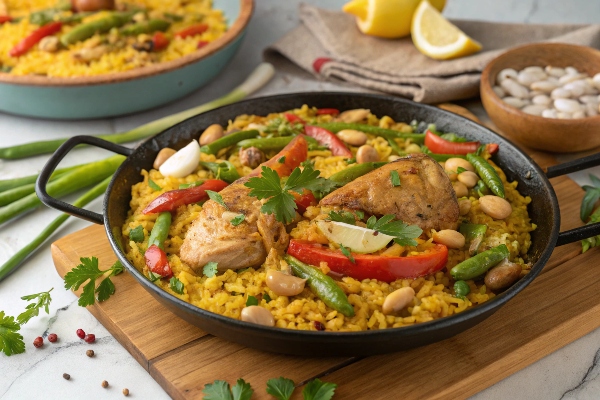
Paella Valenciana was my first taste of the best food in Spain, shared with friends beneath the sizzling Valencian sun. As the saffron-infused rice simmered in a broad, shallow pan, the aromas of chicken, rabbit, and fresh vegetables swirled around us. Each spoonful felt like an ode to tradition—warm, comforting, and reminiscent of communal family feasts. I’ll never forget how locals insisted on creating the perfect socarrat (the crispy rice layer). That mesmerizing crunch became a beloved memory symbolizing the festive spirit of Spanish cuisine.
What makes Paella Valenciana so memorable is its aromatic medley of saffron, paprika, and local produce that merges into every grain. Preparation ranks moderate, requiring careful layering: sauté meats, add sofrito (tomato, onion, garlic), then stir in seasoned rice with stock. Typical ingredients include chicken, rabbit, green beans, and snappy snails, though variations abound. Paella averages around 400–500 calories per serving, with costs moderate for group feasts—a vibrant showcase of best Spanish food traditions and different foods in Spanish celebrations.
Tortilla Española
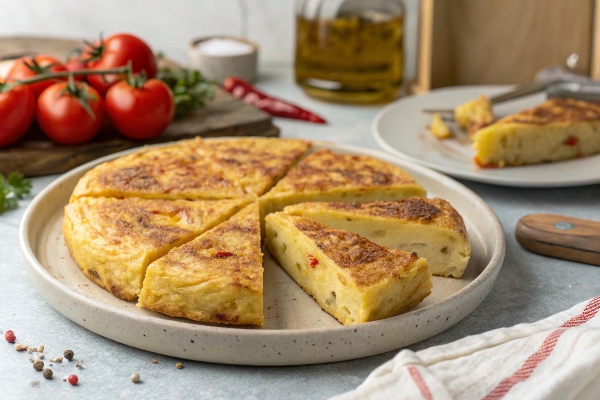
My introduction to Tortilla Española happened in a quaint Madrid kitchen where an elderly cook flipped the tortilla midair. The scene was mesmerizing, much like the flavor: an effortless union of eggs, potatoes, and onions. Biting into that golden wedge of comfort brought home the fact that simplicity is at the core of the best Spanish food. Whether served hot or cold, every creamy, savory slice filled me with nostalgia, evoking images of family gatherings and the cheerful hum of busy Sunday markets.
Tortilla Española’s uniqueness lies in its pillowy texture and sweet onion undertones. Despite easy preparation, care is vital to soften the potatoes and onions in olive oil before folding them into beaten eggs. Then, a deft flip cooks both sides evenly. Expect around 300–350 calories per slice. Budget-friendly and emblematic of Spanish cuisine, it’s hailed among the best food in Spain for turning everyday staples into different foods in Spanish gastronomic bliss.
Patatas Bravas
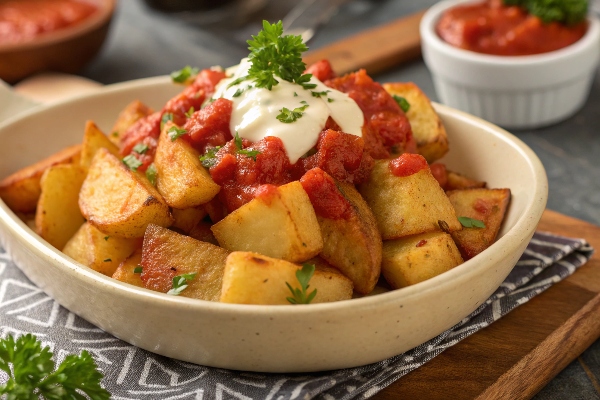
I’ll never forget my first encounter with Patatas Bravas in a lively Barcelona tapas bar. A sizzling plate of crisp potatoes smothered in fiery sauce landed on the table, and a joyous hush fell over the group. My first bite delivered a burst of tangy heat that electrified my taste buds, compelling me to appreciate the playful side of Spanish cuisine. Reminiscent of carefree evenings with friends, Patatas Bravas quickly became one of my cherished memories tied to the best Spanish food experiences.
Bold and zesty, Patatas Bravas transform simple potatoes into a spicy revelation. Achieving that addictive crunch and punchy sauce is relatively easy: fry cubed potatoes, then drizzle with a paprika-spiked tomato sauce or aioli. Each serving runs about 300 calories. Double-frying can enhance crispness—a top tip among fans of the best food in Spain. Patatas Bravas are famously cost-effective, celebrating the ingenuity behind different foods in Spanish culture with a flavorful flourish.
Gazpacho
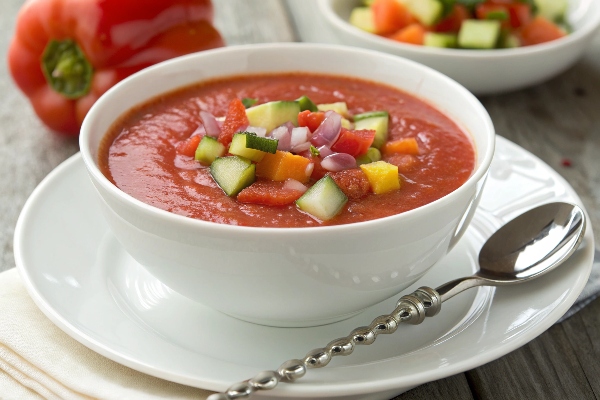
My first spoonful of Gazpacho felt like a cool breeze on a scorching Seville afternoon. The zesty, chilled concoction of tomatoes, cucumbers, and peppers was so rejuvenating, it felt like sipping pure sunshine. As a devout fan of the best Spanish food, I was delighted by the simplicity that captured the essence of Andalusia’s fertile gardens. Each spoonful reminded me of summer strolls, shady patios, and the unhurried pace of life, all culminating in a bright, refreshing celebration of Spanish cuisine.
Gazpacho’s hallmark is its vibrant, fresh flavor blended into a velvety soup. Preparation is easy: purée ripe tomatoes, cucumber, bell pepper, garlic, bread, olive oil, and vinegar, then chill thoroughly. Expect roughly 150 calories per serving. Inexpensive yet nourishing, Gazpacho captures the unpretentious brilliance of different foods in Spanish heritage. A beloved staple among the best food in Spain, it soothes palates and unites hearts during blistering summers.
Pisto
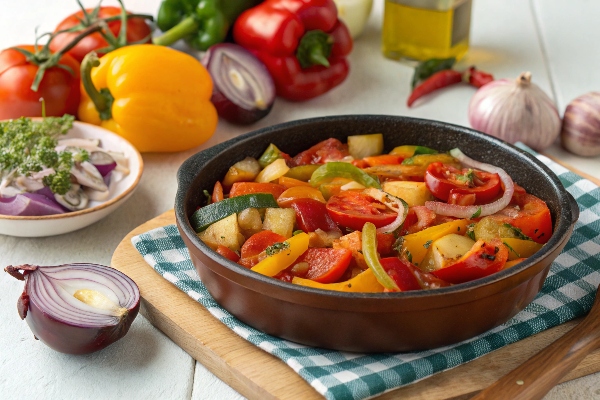
I discovered Pisto in a rustic La Mancha inn, where the gentle simmer of fresh tomatoes, peppers, zucchini, and onions created a medley of inviting aromas. One taste took me back to childhood gardens—abundant sunlight, earthy soil, and crisp vegetables harvested at dawn. Comforting yet light, this vegetable stew felt like a loving embrace from Spain’s countryside. With every spoonful, I understood how the best food in Spain can turn simple produce into a dish bursting with color, warmth, and farm-kissed freshness.
What elevates Pisto is its slow-cooking approach, allowing flavors to meld into a harmonious stew. It’s fairly easy to prepare: sauté chopped onions, peppers, and zucchini, then add tomatoes to simmer into a delicate sauce. Each serving is about 200 calories. Adding a fried egg on top is popular in Spanish cuisine. Budget-friendly and cherished among different foods in Spanish traditions, Pisto proves humble ingredients can yield a genuinely best Spanish food classic.
Jamón Ibérico
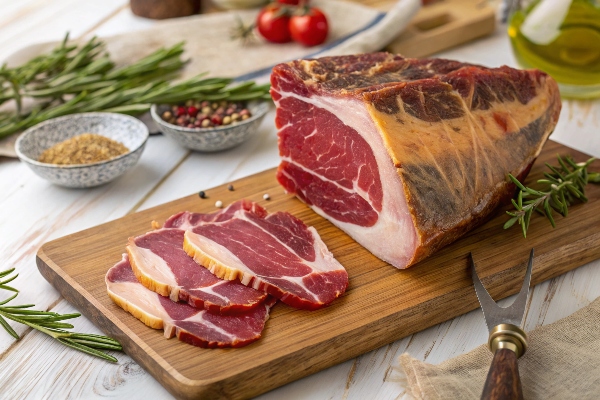
My first paper-thin slice of Jamón Ibérico felt like a revelation. As it gently melted on my tongue, I tasted the richness of acorn-fed pigs roaming oak forests. That exquisite, nutty sweetness was unlike anything else I’d ever experienced. Sharing a platter with locals who discussed aging times and pig breeds, I realized Jamón Ibérico is not just a product—it’s a captivating reflection of Spanish cuisine heritage. The reverence surrounding this ham unveils its rightful place among the best food in Spain.
Jamón Ibérico stands out for its meticulous curing process, which can span multiple years, yielding silky, marbled slices. Preparation requires no cooking—just masterful slicing. At about 160 calories per ounce, its indulgence remains moderate if savored slowly. Although premium in price, it’s prized as one of the best Spanish food icons. Relishing Jamón Ibérico illuminates how different foods in Spanish culture uphold craftsmanship and terroir.
Pulpo a la Gallega

I still recall drifting along the Galician coast where Pulpo a la Gallega reigned supreme at every celebration. The first bite of tender octopus sprinkled with sea salt and paprika opened my eyes to the ocean’s bounty. Gathered around wooden platters with jovial locals, I could taste the salty Atlantic winds and centuries of seafaring tradition. That moment revealed how the best food in Spain often emerges from unassuming yet deeply rooted recipes, bridging families, friends, and travelers in collective delight.
Pulpo a la Gallega captivates palates with its delicate combination of boiled octopus, extra virgin olive oil, and smoky paprika. Preparing octopus can be moderately challenging, requiring boiling until fork-tender, typically around 45 minutes. Expect about 200 calories per serving. Some cooks freeze the octopus beforehand to soften its fibers. Not overly expensive yet deeply flavorful, Pulpo a la Gallega underscores how different foods in Spanish lore enrich Spanish cuisine with oceanic charm.
Croquetas de Pollo

My first encounter with Croquetas de Pollo happened in a bustling tapas bar, their golden hue and savory aroma immediately catching my eye. Breaking through the crisp exterior revealed a creamy chicken filling that felt like the epitome of comfort. Chatting with friends, I savored each morsel, realizing that these croquettes represented so much more than a mere appetizer. They captured the culinary alchemy of Spanish cuisine—taking humble ingredients and shaping them into a morsel worthy of the best Spanish food pantheon.
These croquetas shine through their dreamy bechamel sauce, binding shredded chicken into a silky center. The preparation leans moderate: cook your filling of butter, flour, milk, and chicken, then chill before breading and frying. About 150 calories apiece, they’re indulgent yet perfect for sharing. Reasonably priced ingredients make them accessible, proving how different foods in Spanish homes can elevate simplicity into a hallmark of the best food in Spain.
Fabada Asturiana
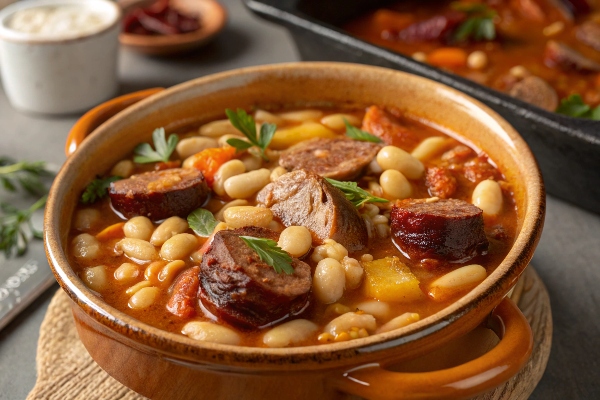
On a chilly day in Asturias, I settled into a farmhouse kitchen where a simmering pot of Fabada warmed the air with comforting scents of chorizo and beans. Each spoonful tasted of hearth and home, a nourishing blend crafted to withstand northern Spain’s rugged climate. As I savored the hearty stew, I recognized the power of the best Spanish food to offer not just flavor, but also a sense of kinship—where mealtime becomes an invitation to share warmth, stories, and unwavering hospitality.
Fabada Asturiana distinguishes itself through slow-cooked white beans, chorizo, morcilla (blood sausage), and pork belly. Though relatively easy, it demands patience to coax out robust flavors, clocking around 500–600 calories per serving. Soaking beans overnight is crucial. Priced moderately for its nourishing yield, Fabada exemplifies different foods in Spanish villages—comforting, hearty fare that reaffirms how Spanish cuisine cherishes communal bonds among the best food in Spain realm.
Churros con Chocolate
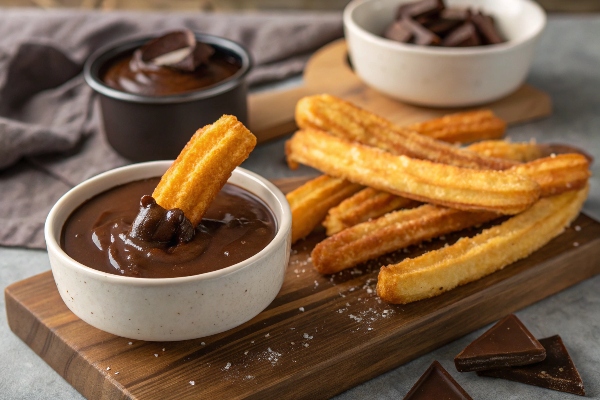
My childhood memories of Madrid would be incomplete without the scent of freshly fried churros floating from street stalls. Standing in line on a crisp morning, I’d watch dough piped into hot oil, forming spirals of irresistible crunch. Then came the velvety chocolate dip, thick and indulgent, transforming each bite into a sweet fiesta. No wonder many claim this treat ranks among the best food in Spain—it merges whimsy and tradition, allowing both locals and visitors to indulge in a moment of pure, sugary bliss.
Churros con Chocolate captivate with their dual textures: crispy dough and luscious dipping chocolate. The dough is easy to make with flour, water, and a pinch of salt, then piped into hot oil. At 200–250 calories per churro, it’s definitely an occasional indulgence. The chocolate sauce demands gentle stovetop stirring until thickened. Affordable and universally adored, it’s a shining star among different foods in Spanish sweets, embodying the convivial spirit of Spanish cuisine.
Tarta de Santiago
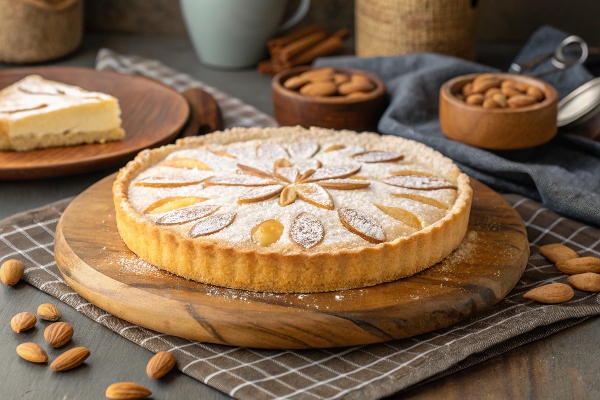
Strolling through the ancient streets of Santiago de Compostela, I was drawn to a bakery window displaying Tarta de Santiago—its top dusted with powdered sugar in the shape of the St. James Cross. The first forkful gave me a moist, almond-rich bite that felt as comforting as a lullaby. That sweet, fragrant slice mirrored the reverence of its pilgrim-frequented city. It’s easy to see why many travelers declare it the best Spanish food dessert, representing faith, culture, and centuries of unwavering tradition.
Tarta de Santiago distinguishes itself through a flourless almond batter, subtly perfumed with citrus zest. A moderate bake, it averages 300–350 calories per slice. Whisk eggs with sugar, fold in finely ground almonds, and finish with a dusting of powdered sugar. Though ingredients can be pricier, it offers a grand finale for any Spanish cuisine feast. Celebrating Camino de Santiago’s legacy, this sweet creation exemplifies how different foods in Spanish culinary tradition encapsulate regional devotion among the best food in Spain.
Conclusion
From the crisp crackle of freshly fried churros in Madrid to the simmering clay pots of beans and chorizo in Asturias, our exploration of these eleven dishes only hints at the vast expanse of Spanish cuisine. Each recipe reflects the soul of its region, weaving together ancestral techniques, local resources, and a deep-rooted passion for life’s simple pleasures. This culinary mosaic helps you understand why so many food enthusiasts worldwide champion Spain’s gastronomy as the best food in Spain—an ever-evolving celebration of heritage, land, and community.
Through these plates, we can trace the footprints of countless generations who have stirred the same soups, flipped the same tortillas, or shaved tissue-thin slices of Ibérico ham with the same reverence. Indeed, the secret to the best Spanish food lies in its ability to remain authentic while welcoming new influences. Farms continually adapt, markets flourish, and families pass down prized cooking traditions, ensuring the flame of Spanish dining never wanes. The dynamic interplay between old-world customs and fresh perspectives allows each region to preserve its identity while fostering culinary ingenuity.
Moreover, few places on earth can boast such an extraordinary variety of different foods in Spanish towns and cities. With each region offering its own signature stews, roasts, and sweets, traveling through Spain becomes a foodie’s odyssey—one that introduces you to local specialties as diverse as the climate and terrain. Whether you’re savoring saffron-laced rice in Valencia or dipping hot churros into melted chocolate at dawn in Madrid, your palate quickly discerns that Spain’s legacy extends far beyond tapas bars and bustling festivals. It’s a country where eating transcends mere sustenance, morphing into a lively ritual that unites friends, family, and strangers alike.
In all these dishes—Paella Valenciana, Tortilla Española, Patatas Bravas, Gazpacho, Pisto, Jamón Ibérico, Pulpo a la Gallega, Croquetas de Pollo, Fabada Asturiana, Churros con Chocolate, and Tarta de Santiago—you’ll notice a common thread: quality ingredients. Whether it’s the succulent tomatoes in Gazpacho, the slow-cured ham from oak-filled pastures, or the robust beans in Fabada, each element stands as a tribute to Spain’s natural bounty. This reverence for ingredients underscores the essence of Spanish cuisine, illustrating how the freshest produce and meats lead to unforgettable dishes that represent some of the best food in Spain.
Finally, the sense of warmth and welcome inherent to Spanish dining cannot be overstated. When you sit down to share a plate of patatas bravas or hand out slices of steaming tortilla, you’re embracing an age-old custom of communal feasting—an invitation to conversation, laughter, and forging lifelong memories. Through these gastronomic experiences, you witness how different foods in Spanish tradition transform simple meals into joyful events, reaffirming why people from all walks of life find comfort and marvel in Spain’s culinary diversity.
No matter where your culinary curiosity takes you, there is always something new and exciting to uncover in Spain’s kitchens, markets, and family gatherings. Every region holds its signature charm; every dish tells a tale of cultural fusion, trade routes, and local landscapes that have shaped Iberian tastes over centuries. In the end, when you delve into these eleven specialties, you’re not merely filling your stomach—you’re partaking in a robust narrative that continues to unfold, bridging ancestral knowledge and modern innovation in each extraordinary bite.
This is why the best food in Spain so effortlessly enthralls food lovers: it resonates with the warmth of tradition, the vibrancy of local produce, and the ever-present joy of a shared meal. From classic staples to reimagined modern plates, Spain offers an endless array of dining experiences that speak to every soul seeking flavor, comfort, and connection. May these eleven dishes spark your appetite and inspire you to continue exploring the varied wonders of Spanish cuisine, knowing that countless more delights are waiting to be discovered in this rich gastronomic tapestry. Buen provecho!
As you savor the Best Food in Spain, it’s only natural to pair these culinary delights with breathtaking destinations. From the sun-drenched shores of the Mediterranean to the historic charm of medieval towns, Spain’s diverse landscapes offer a feast for the senses just as rich as its cuisine. Whether you’re indulging in tapas in a lively plaza or exploring architectural wonders, every experience deepens your connection to this extraordinary country. Now, let’s embark on a journey to 15 Spellbinding Destinations: The Best Places to Visit in Spain for an Unforgettable Adventure!
What is the most famous dish in Spain?
Paella Valenciana is one of the most famous dishes in Spain, featuring saffron-infused rice, chicken, rabbit, and vegetables, cooked in a traditional paella pan.
What are the best vegetarian options in Spanish cuisine?
Spain offers delicious vegetarian dishes like Pisto (a vegetable stew), Gazpacho (chilled tomato soup), and Tortilla Española (potato omelet).
What is the best time to eat traditional Spanish meals?
Lunch (1:30–3:30 PM) is the most important meal, while dinner is typically lighter and served later (8:30–10:30 PM). Tapas are enjoyed in the evening.
What makes Spanish cuisine unique?
Spanish cuisine stands out for its fresh ingredients, regional diversity, and rich traditions, blending Mediterranean, Moorish, and European influences.
What dessert should I try in Spain?
Churros con Chocolate is a must-try dessert, featuring crispy fried dough dipped in thick, rich chocolate, perfect for breakfast or an evening treat.

